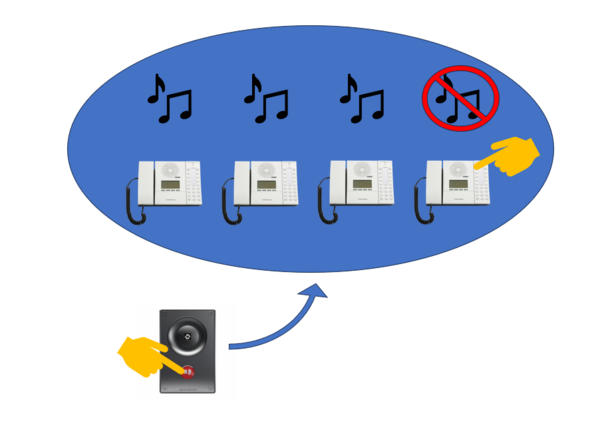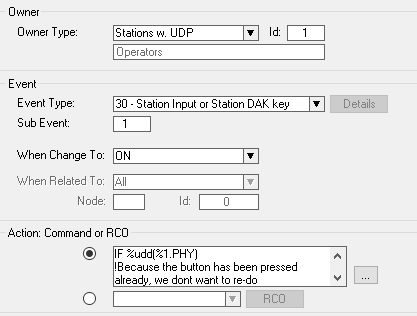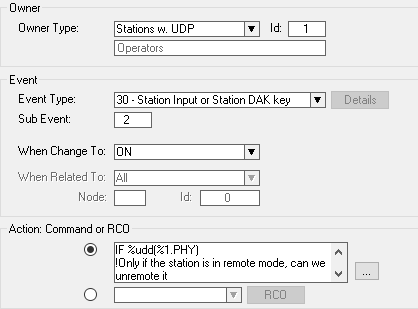Call Request Transfer from Group of Operators: Difference between revisions
From Zenitel Wiki
ZenitelAus (talk | contribs) (Created page with "{{AI}} thumb|right|600px|Call to group of operators <br style="clear:both;" /> When a Call Request or Ringing Group call is sent to a group of operator...") |
ZenitelAus (talk | contribs) No edit summary |
||
| (One intermediate revision by the same user not shown) | |||
| Line 1: | Line 1: | ||
{{AI}} | {{AI}} | ||
[[File:Operator 3.PNG|thumb|right|600px|Call to group of operators]] | [[File:Operator 3.PNG|thumb|right|600px|Call to group of operators]] | ||
When a Call Request or Ringing Group call is sent to a group of operators, it is sometimes required to activate Call Request Transfer to signal that the Operator Position is no longer manned. <br>This can be a manual control by the operator, or it could be an automatic control from a PSIM application, resulting in the Operator position no longer receiving the Call Request or Ringing Group Call. <br>However, all remaining operators should still receive the calls and the escalation should not take place until the last operator has activated the Call Request Transfer. <br>This application provides an example of how to achieve this. <br> | When a Call Request or Ringing Group call is sent to a group of operators, it is sometimes required to activate Call Request Transfer to signal that the Operator Position is no longer manned. <br>This can be a manual control by the operator, or it could be an automatic control from a PSIM application, resulting in the Operator position no longer receiving the Call Request or Ringing Group Call. <br>However, all remaining operators should still receive the calls and the escalation should not take place until the last operator has activated the Call Request Transfer. <br>This application provides an example of how to achieve this. <br> | ||
==Operation== | ==Operation== | ||
*A Dummy Subscriber is added as a permanent member of the group, and all automatic escalations are performed at this dummy station | *A Dummy Subscriber is added as a permanent member of the group, and all automatic escalations are performed at this dummy station | ||
*Operators will press DAK 1, or the PSIM will command DAK 1 to place their location into Transfer. In doing this, they will remove their directory number from the group. | *Operators will press DAK 1, or the PSIM will command DAK 1 to place their location into Transfer. In doing this, they will remove their directory number from the group. | ||
| Line 10: | Line 13: | ||
==Pre-requisites== | ==Pre-requisites== | ||
*1 Dummy Subscriber to be a permanent member of the Call Request group | *1 Dummy Subscriber to be a permanent member of the Call Request group | ||
*All normal escalation programmed against the Dummy Subscriber | *All normal escalation programmed against the Dummy Subscriber | ||
| Line 55: | Line 59: | ||
!Now that UDD 553 is less than 4 | !Now that UDD 553 is less than 4 | ||
$SCRT L105 | $SCRT L105 | ||
!Turn | !Turn off Call Request Transfer at the dummy | ||
ENDIF | ENDIF | ||
ENDIF | ENDIF | ||
[[Category: Applications]] | [[Category: Applications]] | ||
[[Category: Control Room Applications]] | |||
[[Category: Control Room Applications]] | |||
Latest revision as of 03:18, 1 February 2024
When a Call Request or Ringing Group call is sent to a group of operators, it is sometimes required to activate Call Request Transfer to signal that the Operator Position is no longer manned.
This can be a manual control by the operator, or it could be an automatic control from a PSIM application, resulting in the Operator position no longer receiving the Call Request or Ringing Group Call.
However, all remaining operators should still receive the calls and the escalation should not take place until the last operator has activated the Call Request Transfer.
This application provides an example of how to achieve this.
Operation
- A Dummy Subscriber is added as a permanent member of the group, and all automatic escalations are performed at this dummy station
- Operators will press DAK 1, or the PSIM will command DAK 1 to place their location into Transfer. In doing this, they will remove their directory number from the group.
- When the last operator has placed their location into Transfer, the Dummy Subscriber will activate Call Request transfer.
- If any one operator presses DAK 2, or the PSIM commands DAK 2 to turn off Transfer, the Dummy will deactivate the Call Request Transfer
Pre-requisites
- 1 Dummy Subscriber to be a permanent member of the Call Request group
- All normal escalation programmed against the Dummy Subscriber
- 1 UDD for each Operator, related to their Physical number
- UDD 553 to count the number of operators who are in/out of remote mode.
- Modify the Group nummber, number of operators and call request transfer location as required in the below events
Events
Call Request Transfer ON
IF %udd(%1.PHY) !Because the button has been pressed already, we dont want to re-do STOP ENDIF $GRM L%1.DIR L85 U0 !Remote this master from the group WUDD 553 %op(%udd(553),+,1) !Add 1 to the current value of UDD 553 $DTS L%1.DIR 'Remote mode' !Write something to the display WUDD %1.PHY 1 !Set the flag that the button has been pressed IF %op(%udd(553),==,4) !Because 4 Masters are now in remote mode $SCRT L105 L107 !Transfer the call request from the dummy number to the MCR number ENDIF
Call Request Transfer OFF
IF %udd(%1.PHY) !Only if the station is in remote mode, can we unremote it $GRM L%1.DIR L85 U1 !Put the station back in the group WUDD 553 %op(%udd(553),-,1) !Subtract 1 from the current value of UDD 553 WUDD %1.PHY 0 !Unset the flag so the button can be pressed again $DTS L%1.DIR 'Local Mode' !Write something to the display IF %op(%udd(553),<,4) !Now that UDD 553 is less than 4 $SCRT L105 !Turn off Call Request Transfer at the dummy ENDIF ENDIF




